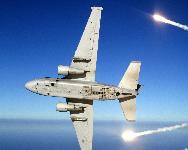
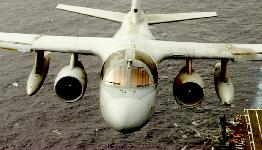
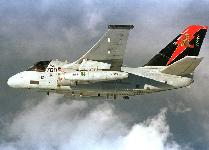
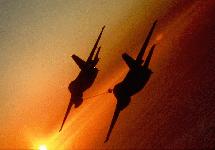
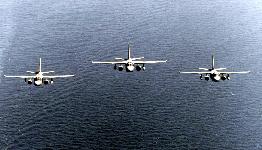
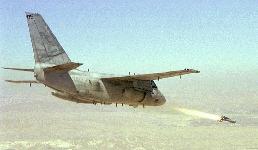
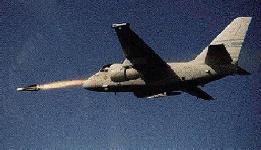
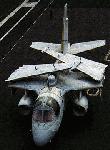
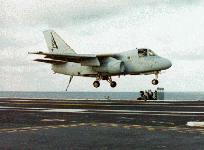
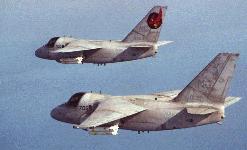
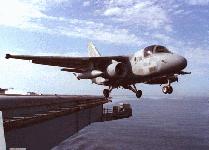
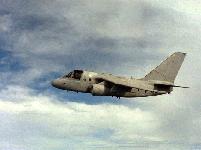
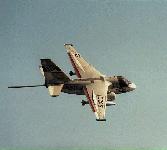
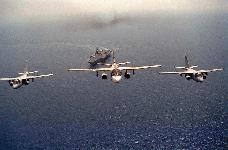



The S-3B's high speed computer system processes information generated by the acoustic and non-acoustic target sensor systems. This includes a new Inverse Synthetic Aperture Radar (ISAR) and ESM systems suites. To destroy targets, the S-3B Viking employs an impressive array of airborne weaponry. This provides the fleet with a very effective airborne capability to combat the significant threat presented by modern combatants and submarines. Additionally, all S-3B aircraft are capable of carrying an inflight refueling "buddy" store. This allows the transfer of fuel from the Viking aircraft to other Naval strike aircraft, thus extending their combat radius.
The S-3B Aircraft is a modified S-3A Anti-Submarine Warfare (ASW) aircraft, with increased ASW and new Anti-Surface Warfare capabilities through improvements to various mission avionics and armament systems. It has increased capabilities through improvements to the general purpose digital computer, acoustic data processor, radar, sonobuoy receiver, sonobuoy reference system, and electronic support measures, and includes the installation of an electronic countermeasures dispensing system and the Harpoon Missile System. It also encompasses provisions for the Joint Tactical Information Distribution System. The Communications Control Group [CCG] provides improved communication capability and greatly improved reliability over the Switching Logic Unit and Intercommunication System used in the S-3A. The Global Positioning System [GPS] modification replaces the Tactical Air Navigation (TACAN) portion of the S-3B Aircraft TACAN Inertial Navigation System once TACAN is phased out. This new navigation system will also comply with the requirement for the S-3B Aircraft to have Federal Aviation Administration certifiable GPS Radio Navigation capability. The GPS will provide increased operational capability and mission effectiveness by providing precise navigation position information during all phases of aircraft operations. The AN/USH-42 Mission Recorder Reproducer Set [MR/RS] replaces the obsolete and unsupportable RO457 Video Signal Recorder. It allows for multi-channel recording of S-3B Aircraft Inverse Synthetic Aperture Radar, Forward Looking Infrared, and mission avionics data. The capability for in-flight video recording, in-flight and post-flight playback, analysis, and duplication are also new features.
Between July 1987 and July 1991, all east coast S-3A Aircraft were modified by a contractor field team at the Naval Air Station (NAS) Cecil Field, Florida. In March 1992, a contractor field team at NAS North Island, California, began modifying west coast S-3A Aircraft to the S-3B Aircraft configuration and completed modifications in September 1994. In early 1995, CCGs were installed in approximately 40 of the S-3B Aircraft at NAS North Island. Installation of the remaining CCGs began in March 1997 and is scheduled to be completed first quarter FY00. The GPSs and AN/USH-42s are scheduled for concurrent installation beginning first quarter FY98 and continuing through the first quarter FY01. The S-3B Aircraft is in Phase III, Production, Fielding, Deployment, and Operational Support phase of the Weapon System Acquisition Process.
In fiscal year 1992, ten aircraft S-3B squadrons were reduced to six aircraft. In 1993, aircraft assets for deployed squadrons were increased to eight, to meet increased operational requirements caused by retirement of the A-6E from the Navy inventory. All S-3B squadrons are currently configured and manned for eight aircraft. The Undersea Warfare Systems (USW) have been removed from the S-3B Viking aircraft. This provides an ideal opportunity for improved technologies to be developed in the S-3B aircraft. The capabilities being tested provide real time tactical data to units on the ground or onboard ships. In the summer of 1999, Commander Sea Control Wing Atlantic (CSCWL) and Commander Sea Control Wing Pacific (CSCWP) embarked on a joint demonstration of the Viking Surveillance System Upgrade (SSU). The Pacific Wing aircraft was fitted with Ultra High Resolution Synthetic Aperture Radar (UHR/SAR) imagery, Joint Tactical Information distribution System (JTIDS) Link-16, Real Time Sensor Data Link (RTSDL) and the AN/AYK-23 Digital Computer. A long range Electro Optical/Infra Red (EO/IR) sensor capable of real time data link to ground and airborne stations was placed in an Atlantic Wing aircraft. The modifications were done at Naval Air Warfare Center, Aircraft Division (NAWCAD), Patuxent River by Veridian contract personnel at Force Aircraft Test Squadron and Naval Air Station, Jacksonville, Florida. This joint effort minimized installation time and cost and maximized visibility.
Specifications | |
| Primary Function | Antisubmarine Warfare and Sea Surveillance |
| Contractor | Lockheed-California Company |
| Unit Cost | $27 million |
| Propulsion | Two General Electric TF-34-GE-400B turbofan engines (9,275 pounds of thrust each) |
| Length | 53 feet 4 inches (16 meters) |
| Wingspan | 68 feet 8 inches (20.6 meters) |
| Height | 22 feet 9 inches (6.9 meters) |
| Weight | Max design gross take-off: 52,539 pounds (23,643 kg) |
| Speed | 450 knots (518 mph, 828.8 kph) |
| Ceiling | 40,000 feet |
| Range | 2,300+ nautical miles (2,645 statute miles, 4232 km) |
| Armament |
Up to 3,958 pounds (1,781 kg) AGM-84 Harpoon AGM-65 Maverick missiles torpedoes, mines, rockets and bombs. |
| Crew | Four |
| IOC | 1975 |













